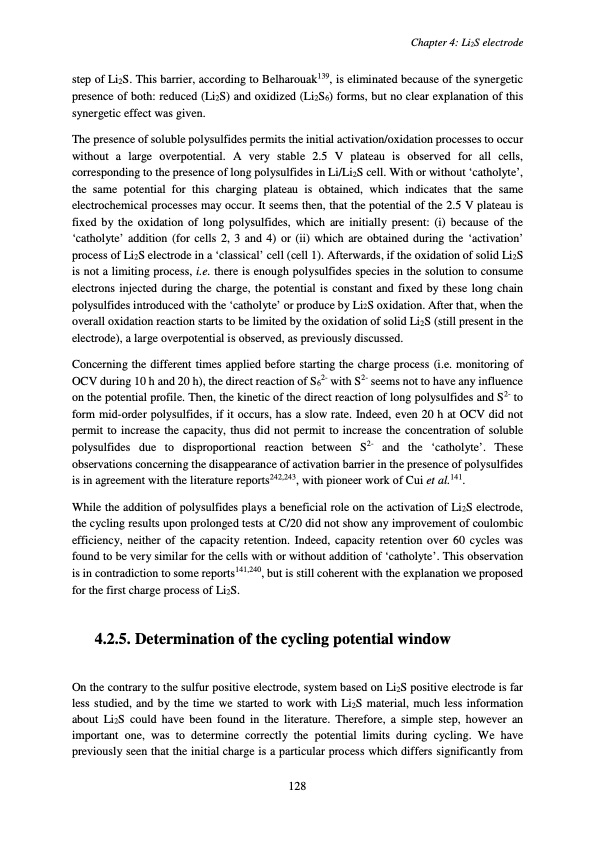
PDF Publication Title:
Text from PDF Page: 132
step of Li2S. This barrier, according to Belharouak139, is eliminated because of the synergetic presence of both: reduced (Li2S) and oxidized (Li2S6) forms, but no clear explanation of this synergetic effect was given. The presence of soluble polysulfides permits the initial activation/oxidation processes to occur without a large overpotential. A very stable 2.5 V plateau is observed for all cells, corresponding to the presence of long polysulfides in Li/Li2S cell. With or without ‘catholyte’, the same potential for this charging plateau is obtained, which indicates that the same electrochemical processes may occur. It seems then, that the potential of the 2.5 V plateau is fixed by the oxidation of long polysulfides, which are initially present: (i) because of the ‘catholyte’ addition (for cells 2, 3 and 4) or (ii) which are obtained during the ‘activation’ process of Li2S electrode in a ‘classical’ cell (cell 1). Afterwards, if the oxidation of solid Li2S is not a limiting process, i.e. there is enough polysulfides species in the solution to consume electrons injected during the charge, the potential is constant and fixed by these long chain polysulfides introduced with the ‘catholyte’ or produce by Li2S oxidation. After that, when the overall oxidation reaction starts to be limited by the oxidation of solid Li2S (still present in the electrode), a large overpotential is observed, as previously discussed. Concerning the different times applied before starting the charge process (i.e. monitoring of OCV during 10 h and 20 h), the direct reaction of S62- with S2- seems not to have any influence on the potential profile. Then, the kinetic of the direct reaction of long polysulfides and S2- to form mid-order polysulfides, if it occurs, has a slow rate. Indeed, even 20 h at OCV did not permit to increase the capacity, thus did not permit to increase the concentration of soluble polysulfides due to disproportional reaction between S2- and the ‘catholyte’. These observations concerning the disappearance of activation barrier in the presence of polysulfides is in agreement with the literature reports242,243, with pioneer work of Cui et al.141. While the addition of polysulfides plays a beneficial role on the activation of Li2S electrode, the cycling results upon prolonged tests at C/20 did not show any improvement of coulombic efficiency, neither of the capacity retention. Indeed, capacity retention over 60 cycles was found to be very similar for the cells with or without addition of ‘catholyte’. This observation is in contradiction to some reports141,240, but is still coherent with the explanation we proposed for the first charge process of Li2S. 4.2.5. Determination of the cycling potential window On the contrary to the sulfur positive electrode, system based on Li2S positive electrode is far less studied, and by the time we started to work with Li2S material, much less information about Li2S could have been found in the literature. Therefore, a simple step, however an important one, was to determine correctly the potential limits during cycling. We have previously seen that the initial charge is a particular process which differs significantly from 128 Chapter 4: Li2S electrodePDF Image | Accumulateur Lithium Soufre

PDF Search Title:
Accumulateur Lithium SoufreOriginal File Name Searched:
WALUS_2015_archivage.pdfDIY PDF Search: Google It | Yahoo | Bing
Sulfur Deposition on Carbon Nanofibers using Supercritical CO2 Sulfur Deposition on Carbon Nanofibers using Supercritical CO2. Gamma sulfur also known as mother of pearl sulfur and nacreous sulfur... More Info
CO2 Organic Rankine Cycle Experimenter Platform The supercritical CO2 phase change system is both a heat pump and organic rankine cycle which can be used for those purposes and as a supercritical extractor for advanced subcritical and supercritical extraction technology. Uses include producing nanoparticles, precious metal CO2 extraction, lithium battery recycling, and other applications... More Info
| CONTACT TEL: 608-238-6001 Email: greg@infinityturbine.com | RSS | AMP |